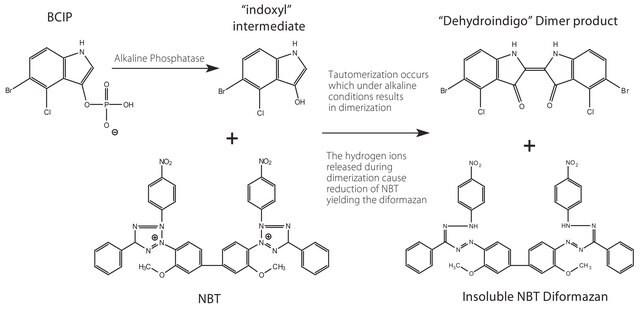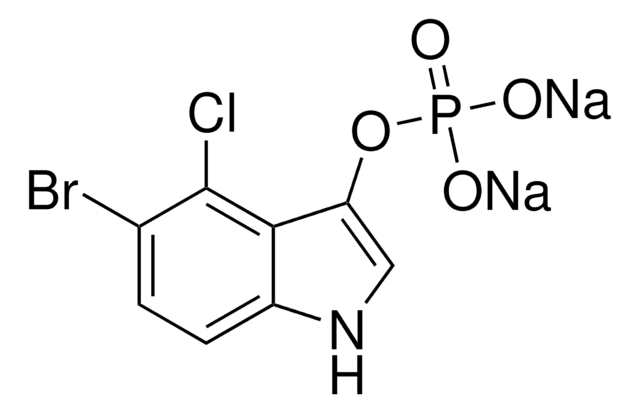Key Documents
11383213001
Roche
NBT
4-Nitro blue tetrazolium chloride, solution
Synonim(y):
Nitroblue tetrazolium chloride
About This Item
Polecane produkty
Poziom jakości
Próba
>95%
Postać
solution
masa cząsteczkowa
Mr 817.7
opakowanie
pkg of 3 mL (300 mg)
producent / nazwa handlowa
Roche
metody
Northern blotting: suitable
Southern blotting: suitable
hybridization: suitable
temp. przechowywania
−20°C
Opis ogólny
Zastosowanie
- Immunohistocytochemistry
- Western blot
- Southern blot
- Northern blot
- Colony and plaque hybridization
- In situ hybridization
Postać fizyczna
Note: The color does not impair the quality or the function of the reagent. In some cases a precipitate may occur which is easily brought into solution by briefly warming the substrate at 37 °C.
Uwaga dotycząca przygotowania
- Always prepare this solution fresh shortly before use!For all applications except DIG System: Add 50 μl NBT solution and 37,5 μl BCIP to 10 ml 0.1 M Tris-HCl, pH 9.5 (20 °C), 0.1 M NaCl, 0.05 M MgCl2.
- For DIG System applications: Add 50 μl NBT solution and 37,5 μl BCIP to 10 ml 0.1 M Tris-HCl, pH 9.5 (20 °C), 0.1 M NaCl
- Note: Do not include MgCl2 in the DIG detection buffer as this might lead to spotty background on the membrane after the detection procedure. Alkaline Phosphatase does not require Mg2+.
Inne uwagi
Hasło ostrzegawcze
Danger
Zwroty wskazujące rodzaj zagrożenia
Zwroty wskazujące środki ostrożności
Klasyfikacja zagrożeń
Acute Tox. 4 Inhalation - Eye Irrit. 2 - Repr. 1B
Kod klasy składowania
6.1C - Combustible acute toxic Cat.3 / toxic compounds or compounds which causing chronic effects
Klasa zagrożenia wodnego (WGK)
WGK 2
Temperatura zapłonu (°F)
167.0 °F
Temperatura zapłonu (°C)
75 °C
Certyfikaty analizy (CoA)
Poszukaj Certyfikaty analizy (CoA), wpisując numer partii/serii produktów. Numery serii i partii można znaleźć na etykiecie produktu po słowach „seria” lub „partia”.
Masz już ten produkt?
Dokumenty związane z niedawno zakupionymi produktami zostały zamieszczone w Bibliotece dokumentów.
Klienci oglądali również te produkty
Powiązane treści
There are several counterstains possible in combination with BM Purple (or NBT/BCIP in general), including FastGreen FCF and Nuclear Fast Red.
Nasz zespół naukowców ma doświadczenie we wszystkich obszarach badań, w tym w naukach przyrodniczych, materiałoznawstwie, syntezie chemicznej, chromatografii, analityce i wielu innych dziedzinach.
Skontaktuj się z zespołem ds. pomocy technicznej









